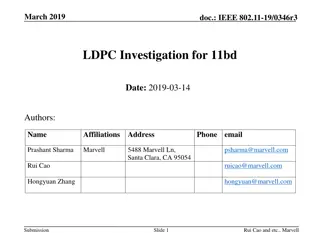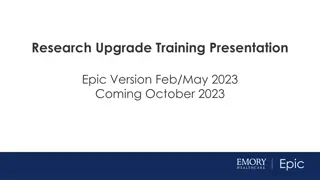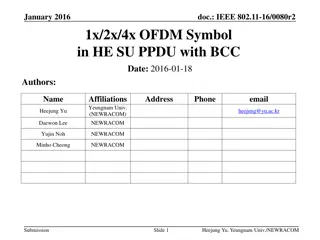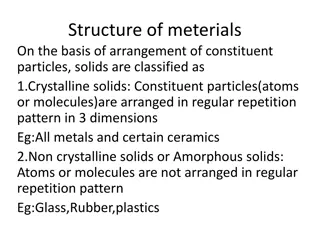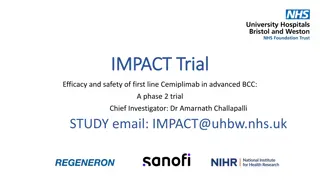
Malting Barley Research and Industry Needs: BMBRI Overview
Explore the Brewing and Malting Barley Research Institute (BMBRI), its objectives, activities, and collaborations with the malting industry. Discover how BMBRI addresses challenges, fosters innovation, and engages with industry stakeholders to advance barley research and quality. Learn about BMBRI's membership, including brewing and malting companies, and associate members contributing to the institute's technical discussions and decisions.
Download Presentation

Please find below an Image/Link to download the presentation.
The content on the website is provided AS IS for your information and personal use only. It may not be sold, licensed, or shared on other websites without obtaining consent from the author. If you encounter any issues during the download, it is possible that the publisher has removed the file from their server.
You are allowed to download the files provided on this website for personal or commercial use, subject to the condition that they are used lawfully. All files are the property of their respective owners.
The content on the website is provided AS IS for your information and personal use only. It may not be sold, licensed, or shared on other websites without obtaining consent from the author.
E N D
Presentation Transcript
BMBRI Representing Industrys Needs in Malting Barley Research and Innovation WBGA BCC Meeting February, 2014 John Holliday Board of Directors Brewing and Malting Barley Research Institute (BMBRI)
Presentation Outline 1. BMBRI Objectives and Organization 2. BMBRI s Related Activities 3. Some Current Malting Industry Challenges and Opportunities 4. BMBRI Collaboration with new AIP Barley Research Cluster Partners 5. Some Conclusions
BMBRI Objectives Provide industry-led Breeding and Research Grants (increasing) Provide industry s quality and agronomy trait requirements to breeders and researchers Collaboratively test and evaluate outcomes (elite cultivars) from breeding programs and provide related reports to industry members and the official variety registration process Communicate information at related forums and meetings Complement other organizations with specific functions in the barley value chain, incl: Grower Commissions (ABC/SBDC), WGRF, WBGA, PRCOB, CMBTC, AAFC, CGC, MIAC, BAC, etc. Participate with these and others under umbrella forums such as Barley Council of Canada (BCC) Over its 65 years most of BMBRI s original objects have been maintained and are still very relevant under a new set of challenges and opportunities
BMBRI Membership Brewing Company Members: Anheuser-Busch InBev, Sleeman, Moosehead, Great Western, Big Rock, Sierra Nevada, New Belgium, Jasper Brewing*, Phillips Brewing*, Picaroons*, PEI Brewing*, Beaus s Brewery*, Village Brewery (Calgary)* *Recent growth in Canadian craft brewing membership in BMBRI s to serve their needs also Malting Company Members: Canada Malting, Malteurop, Prairie Malt, Rahr Malt
BMBRI Membership Associate BMBRI Members and Advisory Members:* Alberta Barley Commission, SeCan, FP Genetics, Syngenta Seeds, Canterra Seeds, CPS Canada, CGC, AAFC, WGRF, American Malting Barley Association (AMBA) and others * Associate and Advisory Members actively participate in BMBRI s Technical Committee discussions and decisions, and assist with Collaborative Tests, etc
BMBRI Operational Structure BMBRI Board of Directors Strategic Direction Financial Direction Approval Technical Committee Grant Recommendations BMBRI Technical Committee Decision on common desired malting barley production and quality trait needs of members Communication of these decisions to breeders/researchers and related funding agencies and forums Soliciting, discussing and recommending related BMBRI research grant funding Coordination of important BMBRI Collaborative Test on elite breeder lines and presenting of related reports to variety registration committees (PRCOB) and other stakeholders BMBRI Management M. Brophy, BMBRI s President and CEO coordinates and implements BMBRI Board and Technical Committee decisions and responsibilities
Summary Summary - -BMBRI s Current List of Desirable Quality Traits BMBRI s Current List of Desirable Quality Traits Characteristic In Breeding For Research Improved Agronomics and Productivity for Growers (this is paramount ) + + Aribinoxylan Measurement + Balanced Modification + Consistent Barley Quality Across Regions + Sensory Properties + + Enzyme Activities * + Extract + + Fermentability + FHB Resistance + Hull Adherence + Long Term Germination + Pre Harvest Sprout Tolerance + Protein* + Varietal Identification +
BMBRIs List of Desirable Quality Traits BMBRI s List of Desirable Quality Traits *Protein-Enzyme Quality Profiles: Moderate protein (11-12.5%) / High enzymes (>150 DP, >53 alpha amylase) Moderate protein (11-12.5%)/Moderate enzymes (125 150 DP, >53 alpha amylase) Moderate protein (11-12.5%)/ Lower enzymes (<125 DP, <53 alpha amylase) Low protein (<11%) / low enzymes (<125 DP, <53 alpha amylase) Above profiles are variety related Some brewing market segments require different specifications and related varieties as above
Barley Improvement in Western Canada (milestones) 1970s to 2000s: The major malting barley breeding program activity became concentrated in Western Canada. University of Saskatchewan: Harrington, CDC Copeland, CDC Meredith, CDC Kindersley, etc Agriculture Canada Brandon: CDC Metcalfe, Newdale, Cerveza, AAC Synergy, etc Alberta Agriculture, Lacombe: Bentley + USA Breeding Program Varieties in Canada Merit 57, Tradition, etc
Recent Improvement in Malting Barley Varieties 1990s to 2000s: Very significant yield, disease and grain quality improvement (better for growers) AC Metcalfe grower yield = 107% of Harrington CDC Meredith grower yield = 113% of AC Metcalfe Improvement in agronomic productivity for growers (but more in pipeline) More desired barley and malt protein range (better for brewers) Improved overall malting barley selectability % (better disease and field agronomics)
Recent Improvement in Malting Barley Varieties,,,2 1990s to 2000s: Lower beta glucans/lower soluble protein in combination (better for brewers) Range of Free Amino Nitrogen (FAN) to suit different brewing needs (better for new brewing segments such as craft brewers) Range of enzyme packages to suit different brewing needs (suitability for different brewing segments) Lower malt peeling (better for brewer) Better extracts and fermentability (better for brewer)
Canadian Barley Area (hectares) 1908- 2011 6000000 5000000 4000000 3000000 2000000 1000000 0 1908 1911 1914 1917 1920 1923 1926 1929 1932 1935 1938 1941 1944 1947 1950 1953 1956 1959 1962 1965 1968 1971 1974 1977 1980 1983 1986 1989 1992 1995 1998 2001 2004 2007 2010 2013
Current challenges/opportunities for barley production in Canada Challenges Declining/stable barley acres and production Competition from other cereals within the grain crop rotation Maintaining/increasing investment in barley breeding and research Opportunities Great international reputation of Canada s malt, varieties and breeding programs Potential for barley as the cereal crop in Canola rotations New Grower/industry/Government R & D funding partnerships BMBRI will participate with other industry stakeholders in addressing these challenges and capitalizing on these opportunities. Examples include- Participation in new AIP Barley Research and Innovation Cluster Working within the new Barley Council of Canada (BCC)
New Canadian Barley Research and Innovation Cluster Major Government of Canada funding under its Growing Forward II (GF II) Agri Innovation Program (AIP) for agricultural research. Federal Government announced close to $8 million for this barley research cluster over next five years. Federal AIP funding is conditional on initial industry funding and industry-led projects. BMBRI is pleased to be providing this industry leadership as part of the funding consortium and group that developed the cluster under the leadership of ABC BMBRI committing close to $0.5 million from industry for 12 projects within the Cluster which will benefit malting barley and our member s needs. BMRBI funding will be focused on malting barley breeding and agronomic research projects BMBRI also providing research and innovation grants for other projects outside of the AIP Barley Cluster
BMBRI Supported Projects within Barley Innovation Cluster (2013-2018) At AAFC Brandon Research Centre : Breeding 2R malting barley varieties for western Canada; Barley Germplasm with Improved FHB Resistance At University of Saskatchewan Crop Development Centre: Breeding 2R malting barley varieties for Western Canada; Genetic markers for Agronomic Traits and Disease Resistance At Alberta Agriculture Field Crop Development Centre: Enhancing selection for malting quality in 2R and hulless barley; Linking Enzymes to Disease Resistance Above programs will use BMBRI desired trait guidelines, but are subject to annual review
BMBRI Supported Projects within Barley Innovation Cluster (2013-2018) At AAFC Lacombe Research Centre: Effect of pre-harvest desiccant application on seed germination, yield and quality of malting barley; Effect of plant growth regulators on yield and quality of malting barley; Quality and yield response of malting barley varieties to increasing nitrogen rates At AAFC Charlottetown Research Centre: Development of improved cultural practices for malting barley production in Eastern Canada (with BMBRI industry funding from some eastern Canadian craft brewers)
BMBRI Supported Projects within Barley Innovation Cluster (2013-2018) Conclusions: BMBRI will continue to work in synergy with other stakeholders within the value chain on areas within our mandate. It is important to leverage resources and expertise of existing organizations within the value chain in a collaborative way and avoid duplication. The Barley Council of Canada (BCC) will be an important body in helping to steer such collaboration. THANK YOU
BMBRI BMBRI Representing Industry s Needs in Representing Industry s Needs in Canadian Malting Barley Innovation Canadian Malting Barley Innovation WBGA BCC Annual Meeting February, 2014 John Holliday Board of Directors Brewing and Malting Barley Research Institute (BMBRI)






